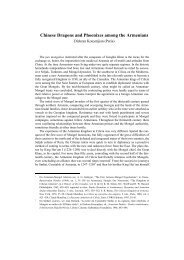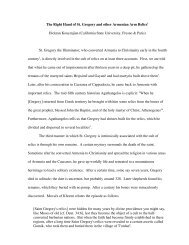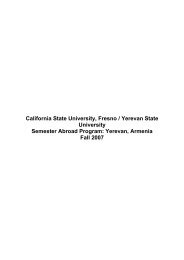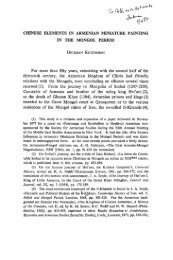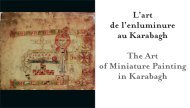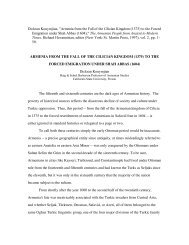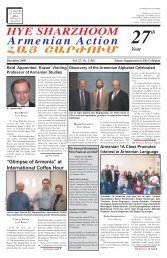Sirarpie Der Nersessian (1896-1989). Pioneer of Armenian Art History
Sirarpie Der Nersessian (1896-1989). Pioneer of Armenian Art History
Sirarpie Der Nersessian (1896-1989). Pioneer of Armenian Art History
You also want an ePaper? Increase the reach of your titles
YUMPU automatically turns print PDFs into web optimized ePapers that Google loves.
Dickran Kouymjian 489<br />
I have dwelt at some length on the miniatures <strong>of</strong> the two Xyleaves, because their interest<br />
transcends the limits <strong>of</strong> Cilician art, bringing, as they do, a notable contribution<br />
toward the study <strong>of</strong> the Stavronikita type <strong>of</strong> evangelist portraits. Among the East<br />
Christians, the <strong>Armenian</strong>s appear to have been the only ones interested in these types;<br />
no corresponding examples are known in Syriac or Coptic Gospels, nor, strangely<br />
enough, in Georgian manuscripts where the illustrations are remarkably close to the<br />
Byzantine models. . . . Ins<strong>of</strong>ar as the study <strong>of</strong> Cilician painting is concerned, the miniatures<br />
<strong>of</strong> the Xyleaves have a somewhat marginal role. They testify to the skill <strong>of</strong> the<br />
painter who faithfully reproduced the Greek model, but . . . are less interesting than<br />
. . . the Lwów Gospels, which, based also on Greek models, show the translation <strong>of</strong><br />
their style into a diVerent idiom. 17<br />
A Wnal example will underline her economy <strong>of</strong> expression—perhaps modesty is a<br />
better word. In the section devoted to <strong>Armenian</strong> painting’s most brilliant and famous<br />
artist, T’oros Roslin (active 1256–68)—the longest part <strong>of</strong> the book devoted to a single<br />
individual, about whom <strong>Der</strong> <strong>Nersessian</strong> had written over and again—she underlines<br />
“Roslin’s ability to convey deep emotion without undue emphasis,” which appropriately<br />
deWnes her own personality. She, too, was for understatement, the idea that<br />
less is <strong>of</strong>ten more. Her most extravagant claims or praise for Cilician art come in this<br />
chapter. Here is her description <strong>of</strong> a painting <strong>of</strong> the descent from the cross: “This<br />
composition, in which Roslin’s hand can be recognized without hesitation, surpasses<br />
in artistic quality the contemporary Byzantine examples.” Or for another scene by<br />
Roslin, she writes, “Christ enthroned between the Virgin and St. John the Baptist—<br />
a Wgure comparable in its noble grandeur to the Wnest medieval examples—is no<br />
longer the severe judge but the compassionate Savior.” And for yet another, “The<br />
compositional design, the delicate modeling <strong>of</strong> the individual Wgures, and the subtle<br />
color harmonies show Roslin’s work at its best, equaling in artistic quality some <strong>of</strong><br />
the Wnest Byzantine miniatures.” 18<br />
Miniature Painting in the <strong>Armenian</strong> Kingdom <strong>of</strong> Cilicia is incontestably her magnum<br />
opus. It is at once a precise and ample study <strong>of</strong> the period and an encyclopedic<br />
compendium on <strong>Armenian</strong> art in general and the history <strong>of</strong> the medieval <strong>Armenian</strong><br />
kingdom.<br />
It has been impossible in this context to compare <strong>Der</strong> <strong>Nersessian</strong>’s earlier positions<br />
on <strong>Armenian</strong> art with corrected or augmented ones in her Wnal study, though an<br />
example was given earlier concerning the Tübingen Gospels. The specialized iconographic<br />
or paleographic background necessary to understand each point would have<br />
required much more space. Rather, I have emphasized her methodology. I do not<br />
mean to suggest that others before and contemporary to <strong>Der</strong> <strong>Nersessian</strong> did not<br />
uphold the same rigorous standards. But few are the scholars from any period and<br />
in any discipline who are able to combine such diverse personal resources and<br />
bring the beneWt <strong>of</strong> such erudition so gracefully to the exposition <strong>of</strong> their research.<br />
Her comments on art are in part so convincing because they are grounded Wrmly on



